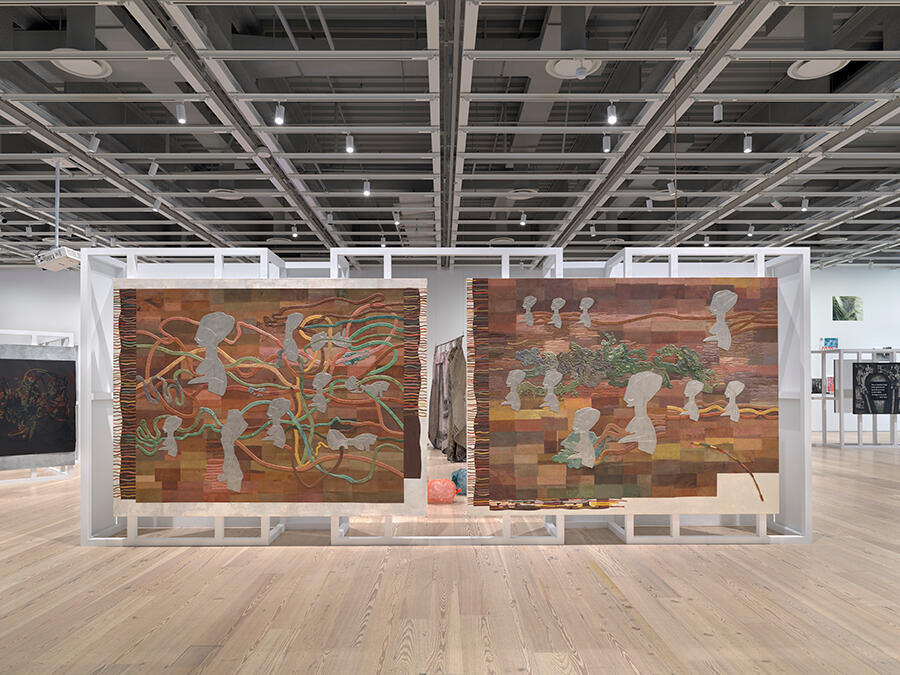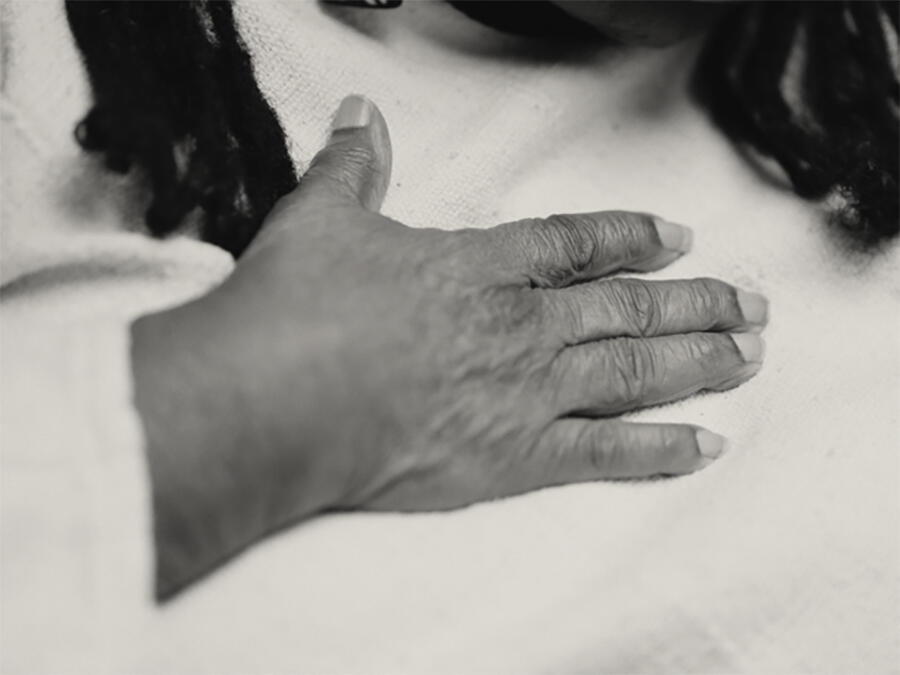The American Predicament of the 2022 Whitney Biennial
David Breslin and Adrienne Edwards’s biennial documents the power of the individual imagination within imperfect nation-state borders
David Breslin and Adrienne Edwards’s biennial documents the power of the individual imagination within imperfect nation-state borders

The curators of this year’s Whitney Biennial, David Breslin and Adrienne Edwards, offer us a provocation in the form of a stark visual binary that structures the show. Featuring the work of 63 artists and collectives, the exhibition unfolds for the most part across two floors that feel wildly different. The fifth floor is completely open, with works installed on freestanding supports and no interior walls to divide up the space, while black paint and black carpet convert the sixth floor into a darkened maze of individual nooks where video abounds. This two-tone approach – which Breslin and Edwards describe in their curatorial statement as a nod to the ‘acute polarity’ that pervades US society – imposes heavily on individual works, with the density of stimulation feeling overpowering at times. I found the simplicity of this division more interesting for how it contrasts with most of the work in the show, which is full of thoughtful eccentricities that take time to unfold. Even when the urgency of overlapping crises amplifies the appeal of grand narratives and righteous clarity, the particularity of the individual imagination still carries great power.

Among the many dark projection rooms on the sixth floor is Alfredo Jaar’s video installation 06.01.2020 18.39 (2022), a re-enactment of a protest following the police murder of George Floyd in 2020. Hand-held footage culminates in two national-guard helicopters making dangerously low passes over the crowd. Jaar underscores this finale with an array of high-power fans that buffet viewers from above as the choppers send protestors running for cover. Failing to add any new layers of meaning to the incident, the work reduces the righteousness of protest to a cliché by pitting it against the inherent evil of cops and soldiers. Civil disobedience is a sign of life in our democracy, but the concept feels cheapened and oversimplified by Jaar’s singling out of one particularly cinematic episode.

Nearby, Sable Elyse Smith takes a more subtle yet effective approach in A Clockwork (2022) – a large, kinetic, Ferris-wheel sculpture made from prison furniture – that presents visitors with the opportunity to stop the creaking machine by pressing the red button on its base. Passively viewing this work means allowing the racist cycle of the prison industrial complex to continue to destroy lives. Even if the guard posted nearby prevents us from actually stopping the machine, the piece radically highlights the culpability of the viewer.
On the fifth floor, adjacent works by Aria Dean and Rose Salane provide the opportunity to ponder thoughtful practices by millennial artists that scrutinize the material and linguistic contingencies of our physical and virtual environments. Dean’s Little Island/Gut Punch (2022) is a bright green rectangle atop a round plinth. The upright pillar shows the signs of a powerful impact in its midsection, but neither the projectile nor its source is present. Dean’s work invokes the immateriality of online affect with its reference to a green screen and anonymous trauma. We are left to contemplate the ripples caused by this mysterious collision while remembering that the whole thing could be rendered invisible in an instant. Salane’s 64,000 Attempts at Circulation (2021) consists of five metal tables piled with coins and other objects. By cataloguing and sorting these items which, despite not being legal US currency, were used to pay bus fares in New York, Salane breaks open the singular notion of value on which a turnstile is based – commemorative tokens deceive the machine just as well as religious icons – and gives form to the friction between a bureaucracy and the ingenuity of its citizens.

Elsewhere, two works by Emily Barker demonstrate differing levels of material and conceptual intensity. Death by 7865 Paper Cuts (2019) is a large but tidy stack of photocopied medical bills accumulated by the artist over the course of six months following a spinal injury. Given that we can only read the topmost invoice, we are left to imagine what invasive procedures and exorbitant costs the pile might contain. With the format of the work emphasizing the quantity of paperwork, the resulting sculpture is not very engaging. Kitchen (2019), by contrast, demonstrates that material pleasure and acute pathos are not mutually exclusive. Oversized, translucent plastic kitchen cabinets form a right angle that glows majestically next to the museum’s large windows. At first, the transformation in scale and opacity makes these boxy shapes feel exalted. The work shifts when the prohibitive consequences of this size become apparent: the countertops are unusable, the upper cabinets completely out of reach. Kitchen brings out the hostility of normative design for those who, like the artist, use a wheelchair. Barker’s enchanting use of material accentuates the sting of this truth.

In a refreshing break from the current market obsession with figurative painting, this biennial contains many compelling examples of abstraction. Several of the most exciting works utilize unconventional supports, such as Rindon Johnson’s richly textured pieces on cow hides (e.g. An Island …, 2022). Johnson stains and marks the leather to create surfaces that are gorgeous and grotesque at the same time, complicating its beauty by using substances, such as indigo and coffee, rooted in the trans-Atlantic slave trade. Dehumanization is a form of abstraction, and Johnson’s work insists that we live with the discomfort of this fact even as we appreciate the pleasure of form.

In the context of such materially inventive work, Leidy Chuchman’s Mountains Walking (2022) is more than six metres long but lacks an effect worth lingering for. In this loosely painted riff on Claude Monet’s ‘Water Lilies’ series (1897–99), a diagonal grid of yellow lines fills each of three panels with wisps of blue and green occurring amid wide swathes of open space. Missing here is the tension that the artist often creates through ever-shifting choices in subject matter. Adam Pendleton’s massive canvases Untitled (Days) (2019–21) feature many layers of silkscreen depicting spray-painted letters. Graphically complex, these black and white works suffer from the too-even distribution of activity across their surfaces. What comes through is technique and scale, but none of the pictorial mystery that painting can conjure.
One of the strangest and most compelling works in the show is a two-channel video by New York-based, Jamaican artist Dave McKenzie. Listed Under Accessories (2022) shows the artist entangled in an ambiguous but earnest struggle with curious objects. For several minutes, McKenzie performs a seemingly improvised choreography with a large sheet of glass. At first, he’s resting the rectangle on his foot and scooting around the room; later, he balances it on the back of his head and shoulders, flexing his neck to keep it level. The rigidity of the glass forces his Black body to adapt in order to handle the material safely. He’s going through something, and we feel it with him even if the parameters of his struggle are never fully explained.

As work like McKenzie’s makes clear, political engagement is not reducible to the choice of an explicitly charged subject. The dynamics enacted within an artwork constitute a power relation of their own – one that speaks directly to our senses. And, while our moment has no shortage of pundits opining on the state of our nation, exploring Americanness through visual culture offers many insights inaccessible to language. Breslin and Edwards’s biennial feels well-suited to our predicament as a country because it offers a vibrant array of human experience and thoughtful visions that outshine their imperfect container.
Main image: Whitney Biennial, ‘Quiet as It’s Kept’, 2022, installation view. From left to right: Veronica Ryan, Between a Rock and a Hard Place, 2022; Awilda Sterling-Duprey, . . . blindfolded, 2020–present; Duane Linklater, a selection from the series 'mistranslate_wolftreeriver_ininîmowinîhk and wintercount_215_kisepîsim', 2022. Courtesy: Whitney Museum of American Art; photograph: Ron Amstutz























